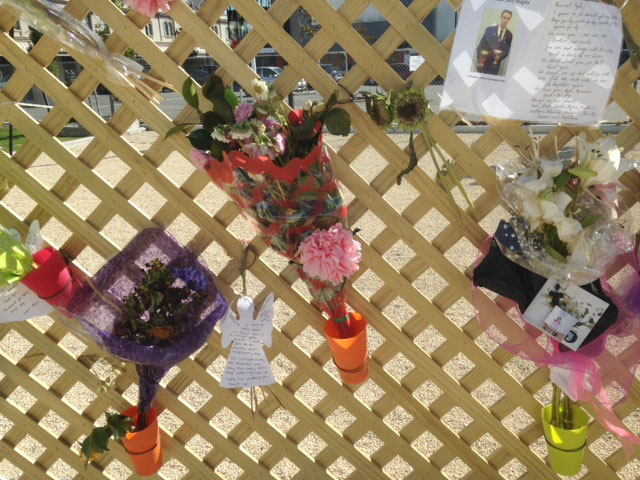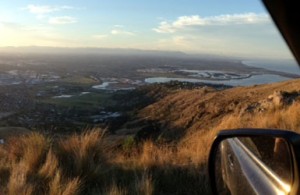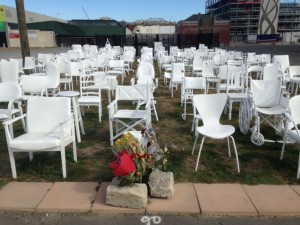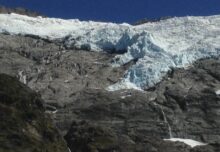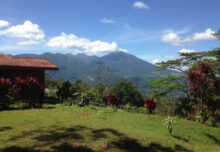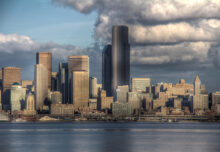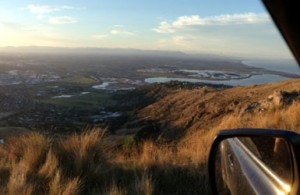
The human aftershocks of the Christchurch earthquake
On our short flight from Auckland to Christchurch I sat next to a New Zealander returning home from a vacation in the States. We chatted a bit and he found out that I’d been to Christchurch ten years previously. You’ll find it changed now, since the earthquake, he told me. I nodded and asked how the earthquake had affected him. It killed my sister and crushed my mother, he said, and steered the conversation in another direction.
The first earthquake rocked Christchurch on September 4, 2010. At 7.1 on the Richter scale it was a big quake and many buildings and roads were damaged, but it was the second quake, on February 22, 2011, a 6.3 tremor very close to the center of the city, that demolished much of the Christchurch downtown and caused the deaths of almost two hundred people. The collapse of a big office building killed 115 and several buses were crushed by debris. Christchurch is built on a floodplain and when the land shook, millions of pounds of mud flowed up into the streets, a process called liquifaction. For weeks the people of Christchurch had no running water or sewage services. Schools were closed and then resumed with double shifts as many school buildings were unsafe for occupation.
While we were in the South Island, Christchurch remembered its dead on the fifth anniversary of the second quake. Memorials now fill spots where buildings once stood and many neighborhoods are gone, the houses bulldozed after it was decided they were too damaged to repair.
After our friend Chris took us on her “earthquake tour” the magnitude of the disaster started to become real for me. Chris said much of the rest of New Zealand thinks the people of Christchurch should get over it, stiff upper lip and all that, but it’s not that easy. Many people are still dealing with their insurance companies and can’t move out or sell their damaged homes. Others are caught in the tight housing market, where prices have soared. Everywhere in the city houses are going up, but it’s not enough.
And there have been hundreds of small earthquakes since the big ones. It does keep people on edge. One night I woke up in Chris’s spare bedroom to what sounded like a freight train coming in the window. The bed rattled, as if shaken by a giant. In the morning I learned it had been a 4.3, a baby quake for my friends. Do they keep expecting another big one, I asked. They shrugged. Even with all our technology we can’t predict earthquakes. For people in a fault zone, it is best to be prepared.
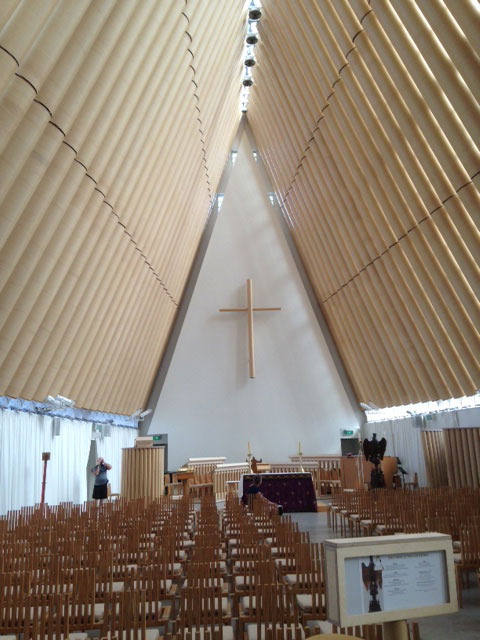
A temporary cathedral made of cardboard tubes stands in for the quake-damaged original. Photo: Tom Vandewater
While we were in Christchurch we visited friends around the city and at each gathering the earthquake stories came out. Our friend Sharee was at home with two young children in her old brick-faced home. Bricks tumbled and plaster fell as she tried to hide under a doorway with her kids. She stayed inside for hours, afraid of falling debris if she should open an outside door. Mark was in his office downtown. He and his colleagues fled but he went back inside the building to make sure everyone had made it out and discovered a ceiling ventilator had crashed onto his desk. Chris was at a meeting and doesn’t remember crunching through glass to get out. She remembers she was wearing a bright blue blouse but the rest of the world had gone black and white for her as she wandered around the crumbled downtown looking for a way to get home.
Immediately after the big earthquakes, five thousand people left the city permanently. Soon university enrollment went down as students transferred to other schools. Our friend Alan is a university professor and his department has a reduced staff, and increased teaching loads. From the stress and anxiety, people in Christchurch drank more and many put on “quake weight” pounds. And even though it has been a time of high need, counseling services have been cut.
But the city is recovering and the new buildings are designed to stay in one piece if the ground shakes again. After our earthquake tour we joined thousands of people in the largest park in Christchurch to see a display of Chinese lanterns, Chinese music, and to eat Asian foods offered from long rows of food stalls. As I munched on dumplings I watched young and old, Asian and Maori and Caucasian, all the faces lit up by the lantern light. Here was a celebration for all the people of Christchurch.
And I have my own earthquake story. At the end of a long February day when Tom and I cycled up two mountain passes, the first one with a headwind so strong it almost knocked me off my bike, we met a stranger in the village of Fairlie. Richard saw us on the main street, two exhausted cyclists looking for a place to camp. I have a big backyard, he said, and I bicycled in the States. We discovered he was a refugee from the Christchurch earthquake, that he and his wife Trish had sold their home and had moved to this small town with their two children to begin over. While he made us dinner we each had a shower and after we ate big piles of pasta we sat late into the evening in conversation with him and Trish and two other new friends, a poet and an artist.
When the tectonic plates that circle the Pacific Ocean push against each other earthquakes and tsunamis beat against the land. It is a risk to live where the earth has so much energy, but it is a risk people have taken for thousands of years. To be a small part of the human aftershocks of the Christchurch earthquakes seems to me to be an honor, a way to recognize the depth of the disaster, but also the renewal that follows.

